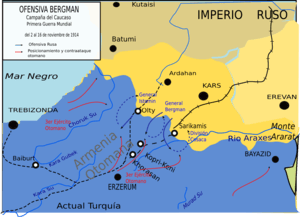Bergmann Offensive
| Bergmann Offensive | |||||||
|---|---|---|---|---|---|---|---|
 | |||||||
| |||||||
| Belligerents | |||||||
|
|
| ||||||
| Commanders and leaders | |||||||
| Hasan Izzet Pasha | Georgy Bergmann | ||||||
| Strength | |||||||
| 80,000[1] | 100,000 | ||||||
| Casualties and losses | |||||||
| Total: 14,023 | Total: 6,000 | ||||||
The Bergmann Offensive (Turkish: Bergmann Atağı; Russian: Берхманнский прорыв; in Russian literature Russian: Кёприкейская операция, "Köprüköy operation") was the first engagement of the Caucasus Campaign during World War I. General Georgy Bergmann, commander of I Caucasian Army Corps, took the initiative against the Ottoman Empire.[5]
At the outbreak of war, the Russians decided to occupy the Eleşkirt valley as a defensive measure to prevent the incursion of Kurdish Hamidiye units. The Russians considered the Turkish forces to be too weak to mount any offensive before winter weather would make any such offensive impossible, and no other offensive moves were intended by the Russian high command of the Caucasian army - their strategy envisaged an active defense against a locally superior force. However, local Russian commanders had the authority to authorize limited advances.[6]
On 2 November, Bergmann's troops crossed the border in the general direction of Köprüköy. The primary aim was to secure the Eleșkirt valley. On the right flank, 20th Infantry Division under Istomin moved from Oltu in the direction of İd.[5] On the left flank a Cossack division under Baratov moved into the Eleșkirt valley towards Yuzveran, after it crossed the Aras River.[5]
By 5 November Bergmann had completed the objectives expected of him. However, he expanded his mission by ordering further advances into Ottoman territory. By 6 November contact was made between the opposing armies, and heavy fighting continued into the 7th, with temporary Russian successes. Further Russian advances were held in check as a result of heavy fighting between 7 and 10 November. On 11 November Ottoman forces counterattacked and the Russian flanks quickly became at risk, forcing a Russian retreat. By the 12th they had retreated back to the lines they occupied on the 4th, and still at risk of being outflanked, further retreats followed. Only the arrival of Russian reinforcements headed by General Przevalski checked the situation and halted the Russian retreat. On 16–17 November Przevalski crossed the Aras river and at dawn attacked part of the Turkish XI Corps, halting their advance. After two more days the fighting finally petered out.[7]
Russian losses were 1,000 killed and 4,000 wounded, 1,000 men died of exposure[3](with the Bakinski regiment suffering 40% losses), while the Ottomans lost 1,983 men killed, 6,170 wounded, 3,070 were taken prisoner, and 2,800 deserted.[3] Yudenich and his staff were disappointed by the unsuccessful attack. Turkish forces then crossed the border and, advancing into the lower Choruh valley, destroyed on 15 November a Russian column sent to protect the copper mines at Borçka, forcing the Russians to evacuate Borçka, Artvin and Ardanuç.[4] Turkish success during these first engagements encouraged Enver Pasha in his plan to attack at Sarıkamıș.[5][8]
Muratoff and Allen describe Bergman as "an officer who liked to imitate in appearance and manner the type of the old Caucasian hero-leaders", but who had "none of the qualities which are necessary as a commander; he had no experience of field operations, and was merely blindly obstinate when he thought to show strength of character".[9]
References
- ↑ Rob Johnson. "The Great War and the Middle East". Oxford University. Page 156.
- ↑ Rob Johnson. "The Great War and the Middle East". Oxford University. Page 157.
- 1 2 3 4 5 6 7 8 9 10 11 Eugene Rogan. The Fall of the Ottomans: The Great War in the Middle East. Hachette UK. 2015. P. 78
- 1 2 W.E.D. Allen and Paul Muratoff, "Caucasian Battlefields", Cambridge 1953, page 248.
- 1 2 3 4 Hinterhoff, Eugene (1984). The Campaign in Armenia. Marshall Cavendish Illustrated Encyclopedia of World War I, vol ii. New York: Marshall Cavendish Corporation. p. 500. ISBN 0-86307-181-3.
- ↑ W.E.D. Allen and Paul Muratoff, "Caucasian Battlefields", Cambridge 1953, page 242.
- ↑ W.E.D. Allen and Paul Muratoff, "Caucasian Battlefields", Cambridge 1953, pages 246-247.
- ↑ Zayonchkovskiy, A. M. (2000). Первая мировая война (Pervaya mirovaya voyna) [World War I] (in Russian). Saint-Petersburg: Poligon. p. 878. ISBN 5-89173-082-0.
- ↑ W.E.D. Allen and Paul Muratoff, "Caucasian Battlefields", Cambridge 1953, page 244.